Whippet 101: The Essential Guide
| Origin | England |
| Size | Medium |
| Height | 18 to 22 inches |
| Weight | 25 to 40 pounds |
| Life Expectancy | 12-15 years |
| Breed Group | Hound Group |
| Affection Level | ⭐⭐⭐ |
| Friendliness | ⭐⭐⭐ |
| Activity Level | ⭐⭐⭐ |
| Barking/Howling Level | ⭐ |
| Pet Friendly | ⭐⭐⭐ |
| Kid-Friendly | ⭐⭐⭐ |
| Shedding | ⭐ |
| Easy to Groom | ⭐⭐⭐ |
| Easy to Train | ⭐⭐⭐ |
Table of Contents
Origin
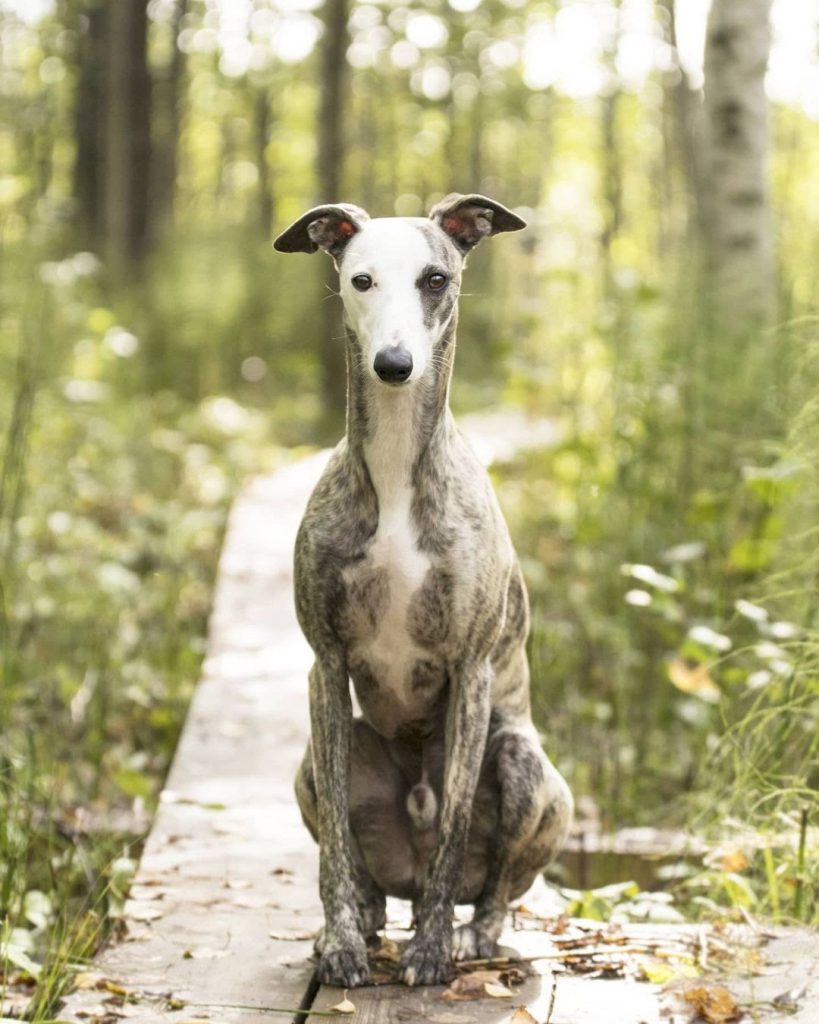

It was during the mid-19th-century when Terriers were crossed with English Greyhounds to develop the Whippet. Later on, to give a sleek and racer appearance, the Italian Greyhound was added to the bloodline. Undeniably, the Greyhounds were the mold for later sighthounds. It is this sweet-natured Whippet that is considered one of the many successful crossbred dogs in history.
Before the Whippet came about, Northern coal miners entertained themselves with dog racing or rabbit hunting during their day-offs. Unfortunately, they as well as many other poor families couldn’t afford the basic needs and care of a large Greyhound. This led them to think about breeding a smaller version. The breeds they worked with to form the Whippet are still uncertain to this day, however, the miners did the job well.
The Whippet, obviously with his appearance, is the fastest dog in his size. Easily, he can reach 35 miles per hour. Not only that, but he is a low-maintenance dog.
This breed has been branded with many names. He’s either “the poor man’s racehorse” or “the lightning rag dog” (as he would chase after a rag dragged through a course which we call as lure coursing nowadays). Later in the 20th century, textile workers from Lancashire left their home country to New England and brought with them the Whippet. That’s when the dog’s popularity started to skyrocket.
Appearance


The Whippet has an elegant and graceful appearance. He is purposefully bred to look thin which serves as a great advantage if he’s out in the meadows running and testing his speed. His sleek body is then complemented by his strong and muscular legs. Common to sighthounds, the Whippet also has a long and fascinating face, a deep chest, and a narrow streamlined body.
According to breed standards, there should only be 2 to 4 vertebrae visible across the back. His round and large eyes communicate a loving and sensitive pooch. Meanwhile, his tail is long and tapers that rests between his legs when he is happy.
Coat & Color
The Whippet’s coat is described to be short, dense, and fine-looking which gives him a striking appearance. Even though he has a double-coat, cold seasons or mild temperatures aren’t for him hence why you’d see some Whippet owners covering their dogs with basic to stylish dog coats.
When it comes to this breed’s colors and markings, the American Kennel Club (AKC) recognizes a variety for any potential Whippet owners to choose from! This includes the following:
| Colors | Markings |
| Black | Black Mask |
| Blue | Blue Mask |
| Cream | WaterMarked |
| Fawn | White Markings |
| White | Black Saddle |
| Red | White Markings, Black Mask |
| Seal | White Markings, Blue Mask |
Size & Weight
It is not uncommon for dog lovers to mistake the Whippet for the Greyhound. However, it is the size that sets him apart from the other sighthound breed. Whippets are generally smaller and his stature is factored by gender.
| Gender | Height | Weight |
| Male | 19 to 22 inches | 34 pounds |
| Female | 18 to 21 inches | 29 pounds |
Temperament


Indoors, the Whippet remains to be calm, chill, and friendly with kids and his owners, but once he steps outside without a leash, he’ll be running off at great speed! It all comes down to his environment. He understands that he has to behave at home. He finds this as a perfect time to please his owners with his unique personality and quirks.
Generally, any dog’s personality is factored in by environment, upbringing, genetics, and training. Whippet puppies who do not have behavioral problems are always curious and playful. They are easily approached by people and would even let themselves be hugged or cradled.
If you are to choose in a litter of pups, avoid those who like to fight and beat up the others in the litter or the ones who are hiding in the corners, seemingly afraid of interactions unless of course, you like challenges. Meet the parents too so you’d have an overview of what to expect from your potential Whippet pup.
Affection


Whippets can naturally become attached to their owners. They are one of the many breeds who like to form deep and genuine relationships. Their extreme devotion always pushes them to ensure that their owners are happy with them. If you already have the Whippet at your home, expect that after a few days of adjustment and familiarization, he’ll start to ask for cuddles and pets!
Moreover, you can trust this breed with your kids as long as there is monitoring. He can play and have fun with them as long as the children are gentle in stroking his back and they avoid touching or pulling his tail. The Whippet is afraid of hurting anyone in the family, however, he might snap or react suddenly to whatever might have hurt him. Don’t worry though, as the chances of this happening are very low.
Friendliness


Anyone would think that any kind of dog would be a great watch or guard dog, but the Whippet’s high level of friendliness disagrees! It is great that he can get along well with the kids, other family pets, or visitors, but if strangers approach even in the middle of the night, the Whippet will remain approachable. He may have all the intimidating canine physical characteristics such as the fangs and his sharp claws, but these aren’t useful when the need for protection arises.
His friendliness trait is an advantage in some ways though. If you are thinking of getting another family pet such as a cat, all you have to do is to properly introduce them to each other. It is much better to get a new pet while the Whippet is still a puppy so his prey drive would turn off at the sight of the new family addition.
Bringing him to dog parks may need caution. Learn first how your dog would react whenever he sees an unfamiliar pooch. If your Whippet has been frequenting doggy daycare centers at an early age, this problem is sorted out.
Activity Level
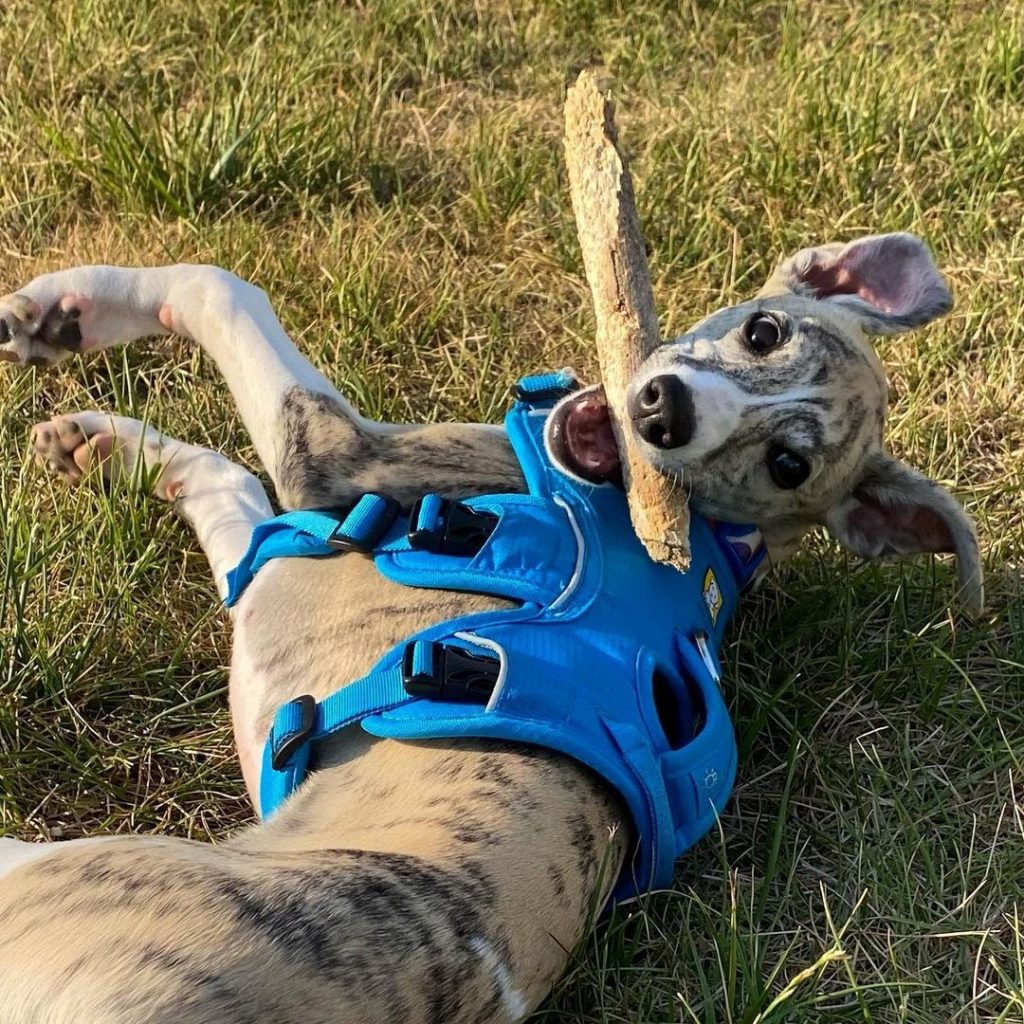

Whippets are slightly more active compared to a standard Greyhound. This specific breed has his periods when he will automatically be running outside, making use of his prey drive, and suddenly collapse like a couch potato. The spike of energy does not just happen when he is outdoors. If you are at home, he will be liable to follow you whichever room you go to or jump on furniture to grab your attention.
At the height of his games, you will hear him bark which is not a common trait for this dog breed. This just shows that he is enjoying the moment. This dog is multi-purpose for families that have little restless kids. The Whippet can outmatch their energy until the little ones fall subconsciously on their beds.
Care
Branded as a low-maintenance breed, the Whippet won’t demand a lot of your effort and resources. Thanks to his coat and normally healthy genetics, taking care of him won’t be that extensive compared to most dog breeds out there. He is a pro at adjusting to new situations whether it be a change in his meal or schedules for grooming, but always remember that basic and proper care is still required.
Grooming
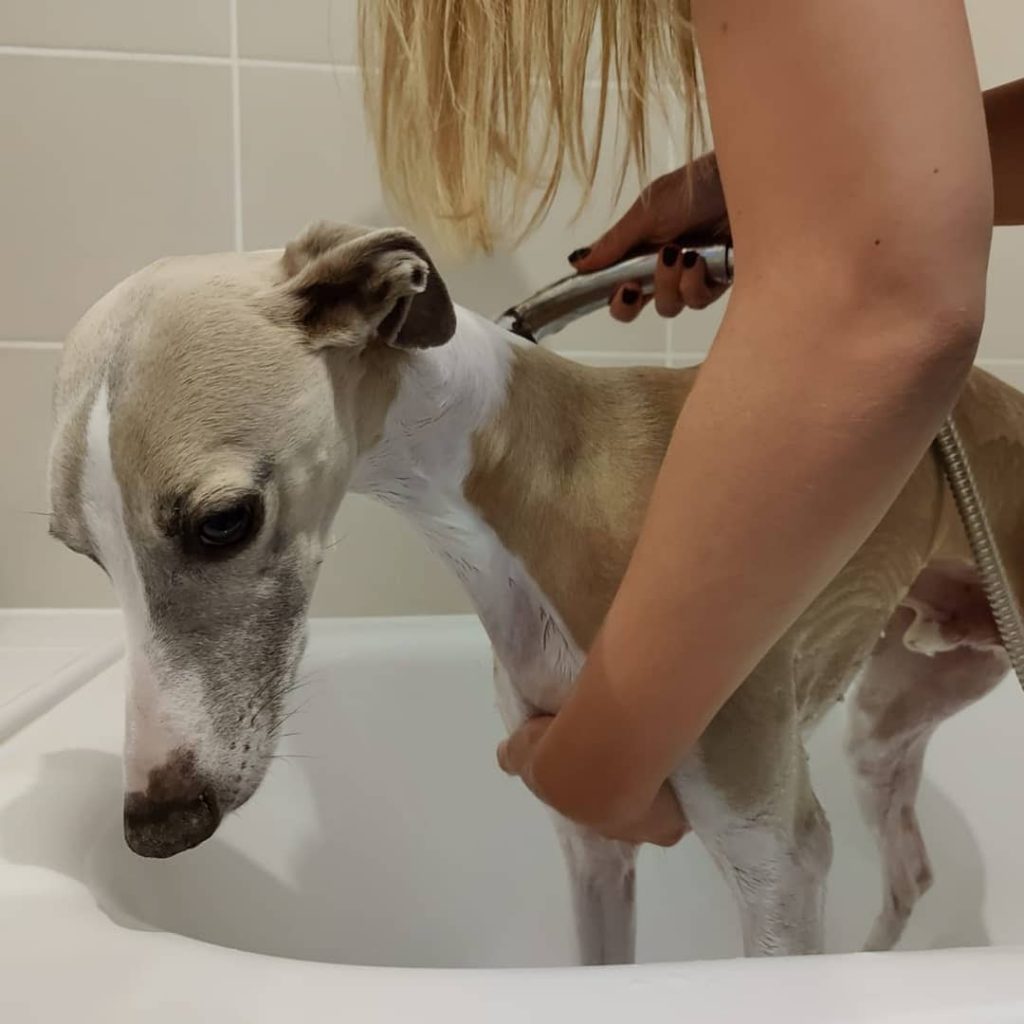

Brushing your Whippet dog once a week is enough to keep him neat and tidy. Even if he sheds, there won’t be wads of hair sticking on furniture or carpets. Expect that he’ll have more loose hairs during spring and fall so ready your vacuum and hairbrush! When it comes to his nails, ears, and anal glands, a 4 to 8 weeks interval for grooming is recommended. Check for any signs of infections or anything that would require immediate medical attention.
When it comes to baths, the Whippet needs to have it every 4 to 6 weeks. Each bathing session has two parts which include the normal one followed by the conditioning bath. All products to be used must be appropriate for your canine. If he has allergies, resort to using hypoallergenic shampoo and conditioner recommended by your veterinarian.
Food and Diet
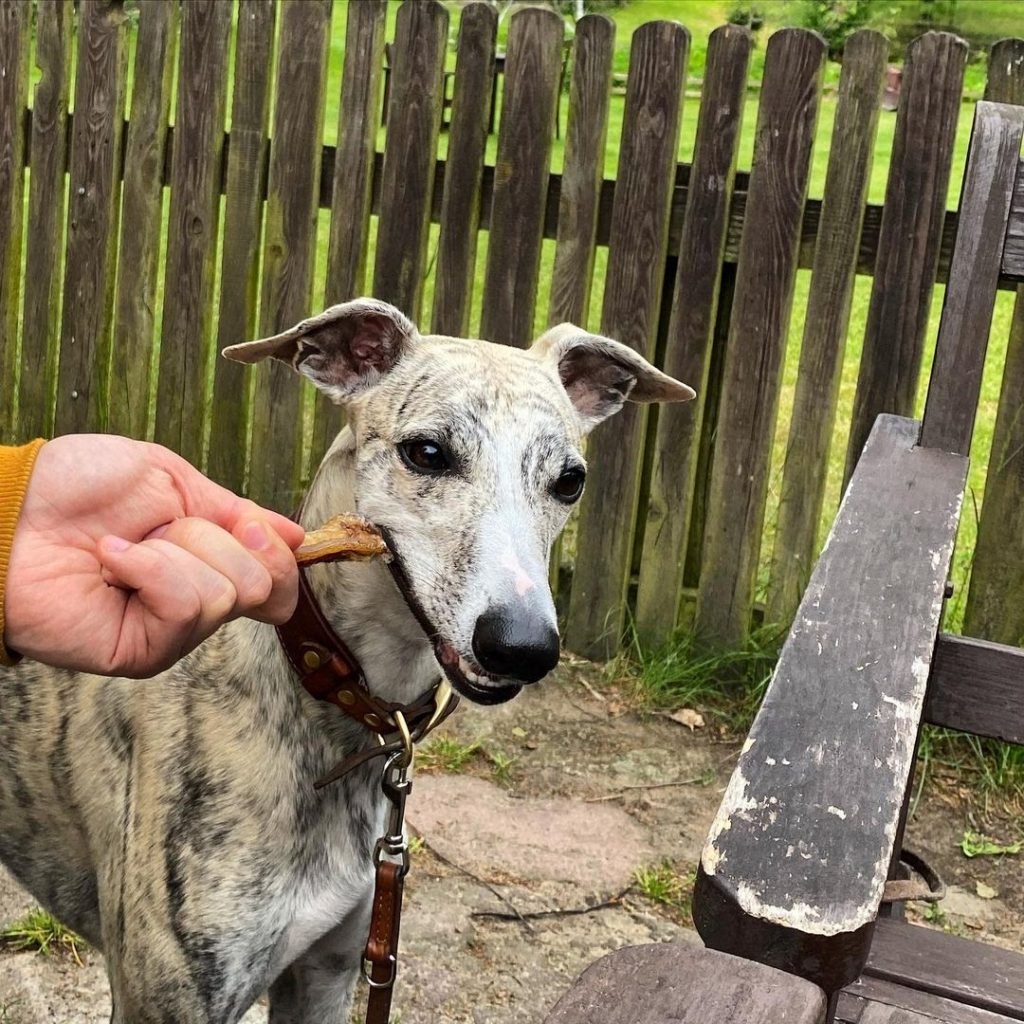

Feeding the Whippet with high-quality dog food served in the right amounts sets him up for a healthy life as he grows up to adulthood. At about 8 months, this high-speed canine reaches its adult size and would normally no longer have to gain more weight. It is important to know that he is bred to be slim and thin, so overfeeding him should never occur to avoid any health issues.
Switching Diet
Upon the arrival of your Whippet,you must let your puppy stick with the kind of meals his breeder gives him for a few weeks. Give him time to transition and adjust to the new components of the food to avoid upsetting his stomach. Slowly incorporating the new food bit by bit with the old diet without changing the amount of his intake is how you do it.
Whippet Diet
Whippets will do well on several kinds of meals and diets as long as they are nutritious and well-managed. For Whippet pups, they would require meals that are high in protein and calories. Almost half of these nutrients are responsible for their growth and development, so try to not go cheap with their dog food.
Feeding Changes
Puppies need to be fed more often than adults. Each day, you have to serve them a fresh bowl of high-quality dog food 3 to 4 times. By the time he becomes an adult, you can start shifting it to just 2 meals a day. Do the same gradual method when you begin to switch your puppy’s food to meals suitable for an adult Whippet. A general guideline regarding the amount is one ounce for every 2 pounds of your dog’s weight.
Being meticulous about your dog’s intake is necessary. If you want to be sure that you are feeding him right, ask for recommendations from your vet.
Exercise
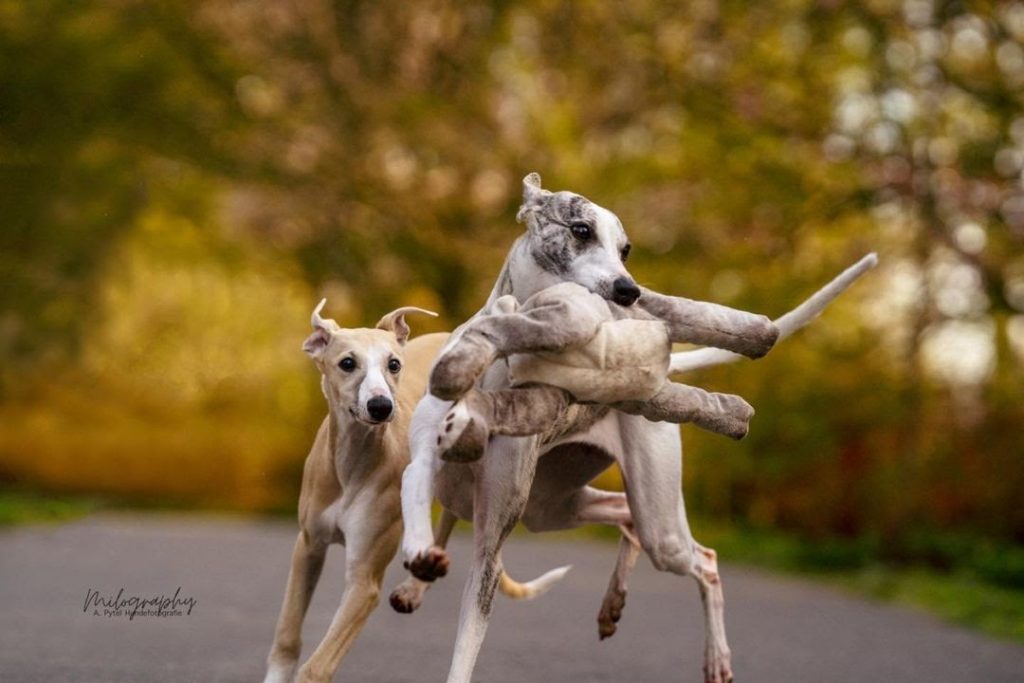

Your Whippet would need at least an hour of exercise each day. This has to be divided into two sessions- a short walk in the morning and a longer time in the afternoon for adventure-seeking such as sniffing or running around an enclosed yard or area.
This general rule for this breed’s exercise will start to vary for every individual pooch. If you notice him being active all day, you don’t have to be strict with the one-hour exercise. However, if your Whippet is a real couch potato, you have to ensure that he gets moving. If there are any signs of excess weight gain, a more strict exercise schedule would be needed.
Training
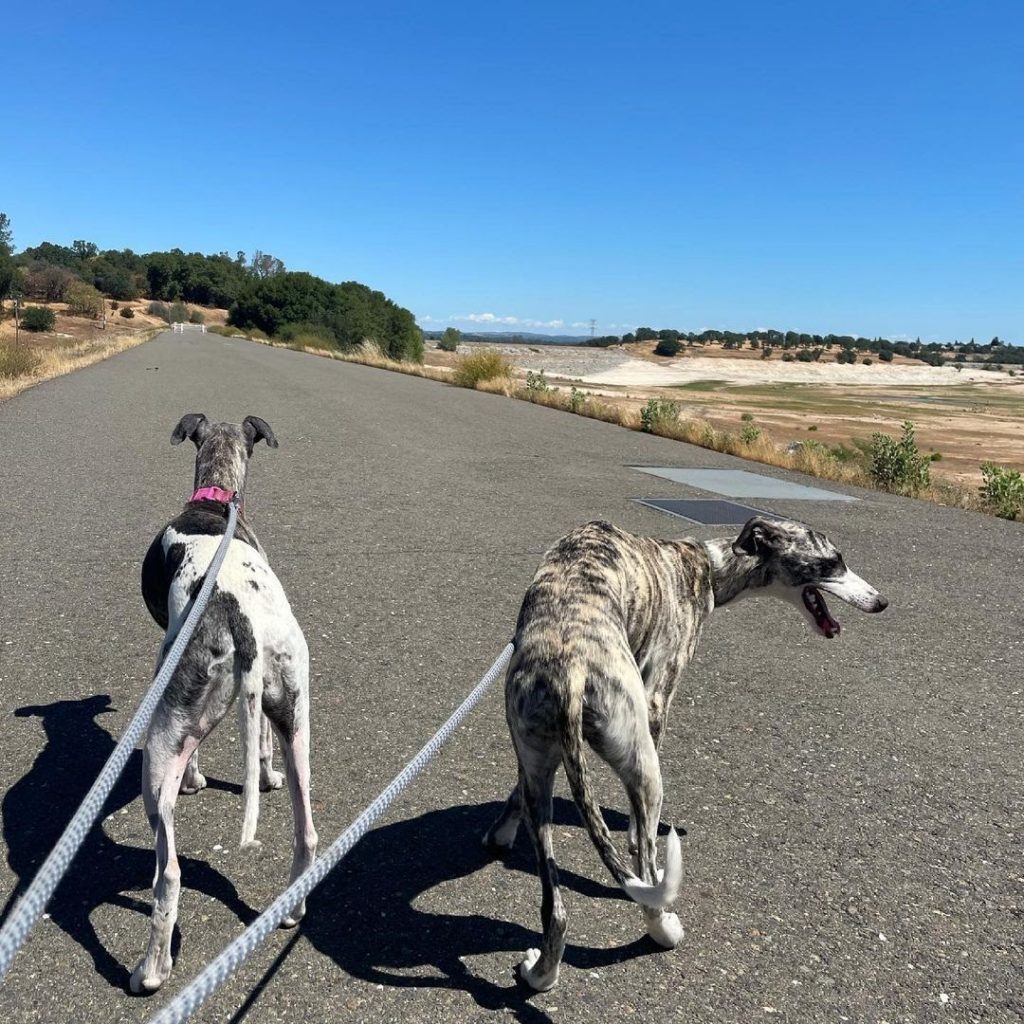

You can live a much easier and more enjoyable life with your Whippet if he is trained well. If your dog is new to training and house rules, starting with the basics will help him learn things quickly. Training does not have to be too overwhelming or expensive. You can do this at home through helpful video tutorials you can find on the internet and purchase toys that will add challenge to the games.
As you start, you have to know that commitment is essential. Lots of dogs are neglected and have ended badly, but a true dog lover will be consistent when it comes to teaching his Whippet the tricks and rules in the house. Training is a means to better understand your dog and his needs. Through his body language, you will instantly learn if he is anxious and needs comfort. It also avoids any tension since dog training prevents your dog from soiling the house such as your expensive carpets or furniture.
Considering how fast a Whippet can run, leaving him off-leash in an open area won’t be a good idea. However, dogs such as this one, are not a big fan of feeling leashes on their necks. If they are used to having it since they are young, you will save yourself from having a hard time trying to put it on when it’s time for a walk in the park.
Health Problems
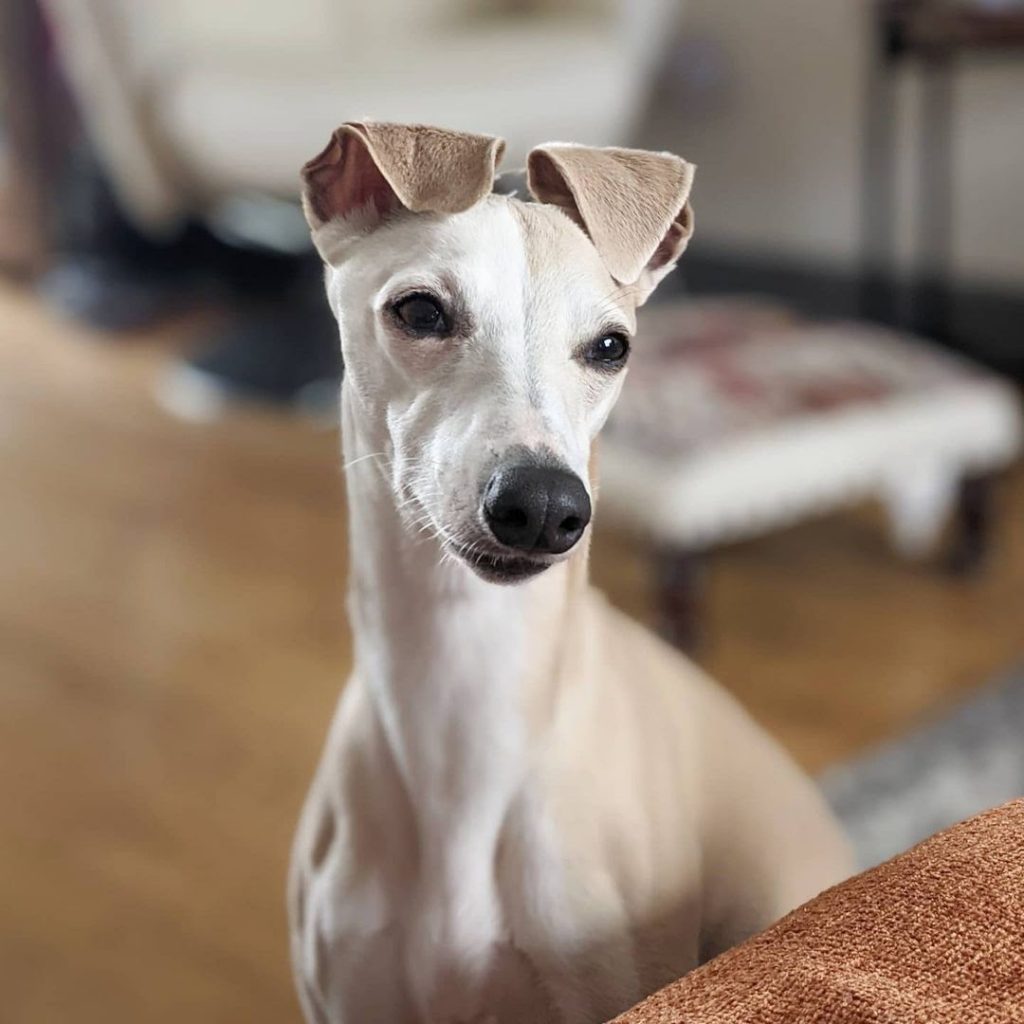

Whippets are delicate by nature. With their short coat, they are prone to cutting themselves on thorns or any other sharp objects. They can also have injuries if they run on uneven grounds, so checking for any obstacles in the area will prevent these from happening.
Putting aside the possible health issues caused by the external environment, this breed may also suffer certain health conditions:
Hypothyroidism
Hypothyroidism is when there isn’t enough production of thyroid hormones which will slow down the dog’s metabolism. This can be treated by regularly providing your Whippet with hormone pills prescribed by your vet. Luckily, this is considered a rare genetic disease and only a few percentages of Whippets can be affected.
Cardiac Disease
Sadly, cardiac disease is becoming prevalent in this precious breed. This led to the American Whippet Club conducting a long-term study on Whippet hearts. Highly emphasize the need for regular checkups for your Whippet as this can be a way to detect early signs and symptoms of an enlarged heart.
Epilepsy
You’ll instantly know if your Whippet suffers from epilepsy once you see his body jerking, collapsing, mouth-foaming, drooling, tongue chewing, or if he suddenly loses consciousness. Epilepsy usually shows up anywhere between 1 to 3 years of your dog’s age and can be treated through prescribed medications.
Bully Whippet Syndrome
This is a genetic trait caused by irresponsible breeding. What this does is it makes your Whippet’s body look more muscular like that of a bodybuilder. This is becoming a rare condition these days thanks to reputable breeders who value health over profit. Currently, there are no treatments to eradicate it.
Pros and Cons of Having a Whippet
Pros
- Whippets are great indoor dogs
- They are smart
- They like to please their owners
- Great exercise partner
- Easy to groom
- Moderate shedder and has little to no odor
- Great for hunting
- Elegant and graceful-looking
- Great with kids
- Energetic outdoors
- Very approachable
Cons
- Requires daily exercise
- Too friendly even with strangers
- Not a good watchdog
- He gets cold too easily
- He sheds regularly
- May exhibit stubbornness
- Does not do well if he’s left alone
- He can go crazy at the sight of a squirrel or rabbit
Do Kennel Clubs Recognize the Whippet?
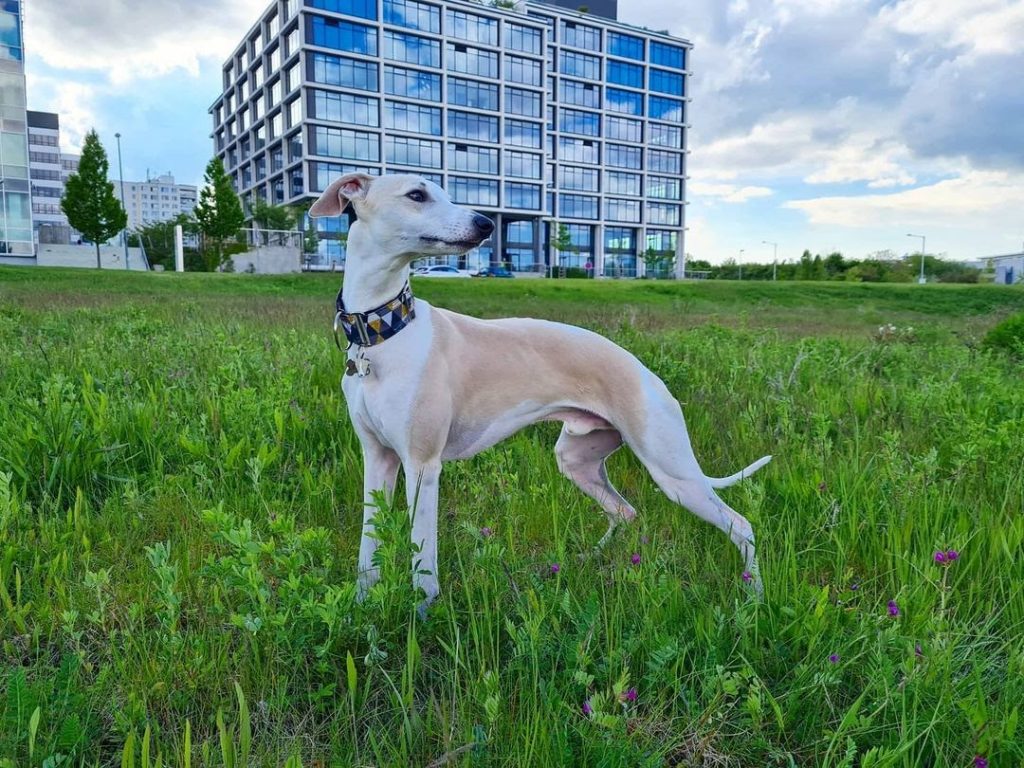

Yes! The American Kennel Club recognized the Whippet dog as its 46th breed in the year 1888. The Kennel Club followed two years later which made this dog eligible for dog competitions. The breed currently ranks 61st in breed popularity out of 197 dogs recognized by the AKC. In 2018, a Whippet named Pinnacle Tennessee Whiskey won Best in Show at the 2018 AKC National Championship.
Cost
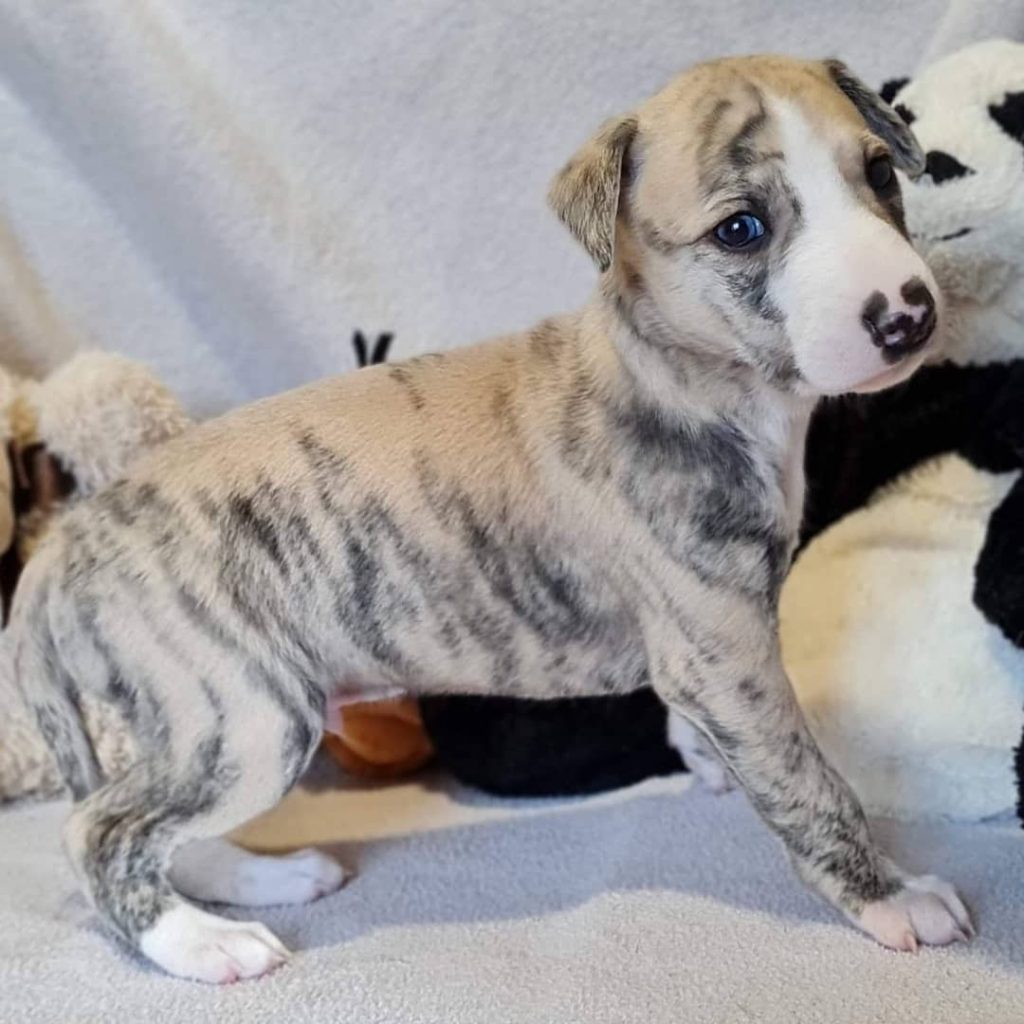

These friendly dogs can cost anywhere from around $1000 to $1500. As expected, the factors that may affect the price are the breeder’s reputation and quality including the pup’s pedigree. The color may also higher or lower the price, but remember that no dog color is perceived to be more desirable or valuable. Perhaps, some breeders may take advantage of the rarity of dun-colored Whippets which only appear every 1500 to 2000 births. However, this should not overshadow the importance of getting a healthy Whippet.
If you are looking to adopt a Whippet puppy, you’ll be paying much more cheaply for only $200 to $500. Once you bring home your Whippet puppy, initial costs which include deworming, physical exam, blood testing, microchipping, and other basic items your dog might need can run up to $500.
An annual budget of $145 is going to the foods and treats, $500 for a year of veterinary costs, while other miscellaneous needs and license costs around $200. In total, the annual starting figure is estimated to be around $845.
Where to Adopt or Buy a Whippet
Whippets are close to perfect as companions or family pets. Their calm demeanor and high-spirited nature can easily attract anyone including you! Getting one is now easy and to make sure that your Whippet is healthy, here are the places you can visit for reliable breeders:
Adopting will always be the best option when it comes to getting a dog companion. For great Whippet rescues, here are the following shelters you can contact:
You will never go wrong with having a Whippet. Not only does he look strong and fast, but his temperament sure is one of a kind! He’s the most behaved dog you’ll ever have with fewer worries of him getting into trouble. In owning a Whippet, he would need only one thing- love and lots of it!
